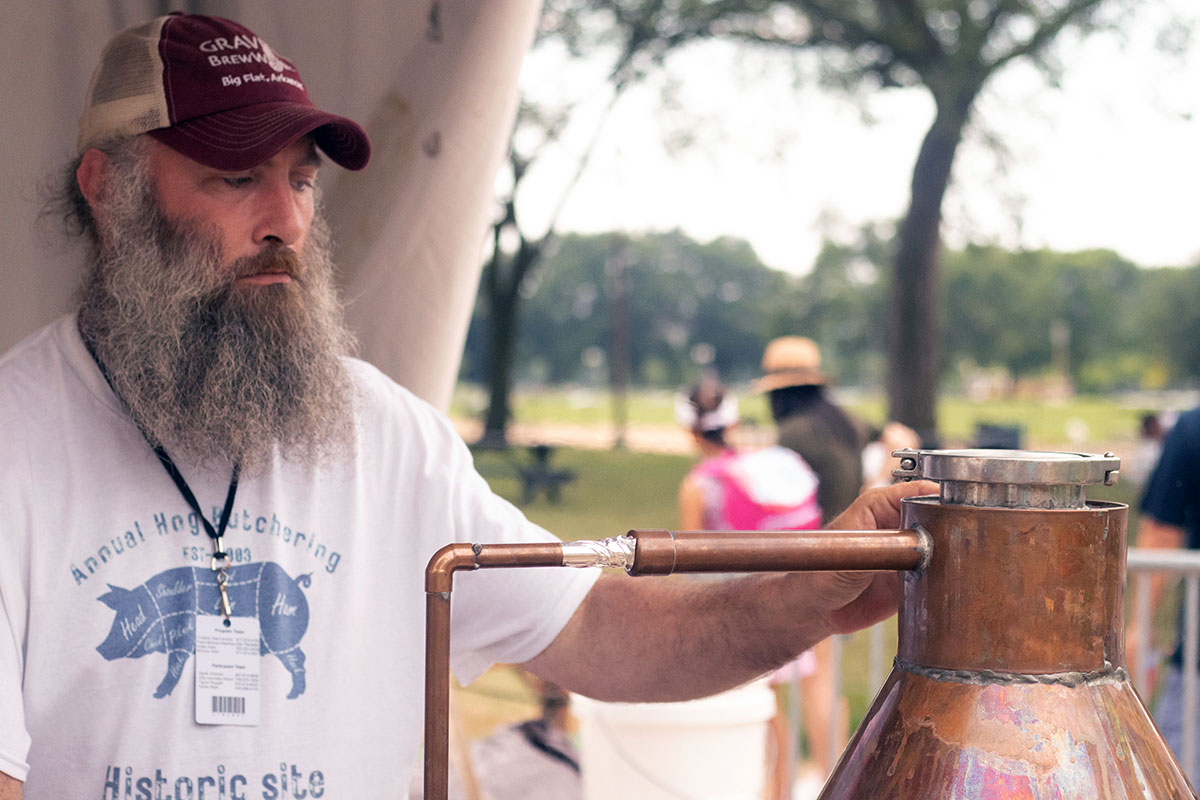The “Gray Areas” of Moonshine Making and Meaning in the Ozarks

Nick Nichols demonstrates the distilling process at the 2023 Smithsonian Folklife Festival.
Photo by Shannon Binns, Ralph Rinzler Folklife Archives
“I came into this the backwards way, really,” said Nick Nichols.
As a coppersmith in Stone County, Arkansas, he would be called in to fix a “pot” with a hole burned in it. With $100 in copper and a couple hours, he would patch it up. “You handed the client a bill, and he kind of looked at you funny and handed you a five-gallon bucket of clear liquid.”
That clear liquid? Moonshine.
The 2023 Smithsonian Folklife Festival had just opened for the day, and visitors were still filing into the National Mall, but it wasn’t too early for alcohol—or, at least, talk of alcohol—at The Front Porch venue of The Ozarks: Faces and Facets of a Region. Visitors gathered to listen to a conversation guided by sixth-generation Ozarker Curtis Copeland and featuring Arkansas hobby distillers Nick Nichols and Matthew Sloan, along with the Ozark Beer Company’s Marty Shutter.
As someone who doesn’t drink and isn’t even old enough to enter a bar, I attended the narrative session “The Importance of Water (Distillation, Recreation, Cooking)” expecting to learn more about conservation and the clear liquid I do drink—water. But I was soon drawn into a conversation that emphasized the scientific, medicinal, economic, and even artistic aspects of alcohol production and consumption in the Ozarks region.
Moonshine is high-proof alcohol, the clear liquid in that mason jar you might have stashed in the pantry, created and/or distributed illegally. Those working at night to distill the liquor are moonshiners, and those selling or dispersing bottles of it, historically hidden in their high-legged boots, are bootleggers.
Cameras: Eve Moore, Nadya Ellerhorst
Sound: Hayden Draycott
Editing: Eve Moore
An Ozark tradition dating to a time before Prohibition, moonshine is often made in makeshift stills such as those that Nichols fixed in exchange for a bucket of the liquor. Traditionally, this means fermenting corn, sugar, water, and yeast, which is then distilled. The stills, often made of copper, are raised to a temperature hot enough to evaporate the alcohol, which is then collected, but not the water.
“We’re taking a giant volume of ten percent alcohol, and what we want at the very end is sixty percent. We want to condense the mixture,” Sloan explained. Throughout the Festival, Nichols and Sloan shared this moonshine-making process at the Distilling tent, highlighting the multiple facets of the practice.
Once the moonshine is made, it begins a new life as a canvas for various herbs, fruits, and other flavors.
On the other side of the Ozarks program area, I visited the herbalists who made the trip to D.C. They explained how moonshine can serve a very different purpose: as herbal medicine. Susan Belsinger described how to unlock this ability in tinctures, herbs soaked and bottled in alcohol. Choosing from a selection of tinctures, she shared one derived from ashwagandha, a plant known to reduce stress and anxiety. “Each plant has different medicinal actions,” she explained.


Nichols and Sloan also described experimenting with adding fruit to moonshine recipes. Ozarkers often hand down these recipes through generations, but sometimes they use whatever is lingering in the pantry or expiring in the garden.
“It was practical,” Nichols said. “Depending on who you talk to or whose granddad was doing it—what did they have?”
If they were lucky, they had what Copeland described as “the Ozarks’ banana”: the pawpaw, North America’s largest native edible fruit. When included in moonshine, this “vegetative treasure,” Copeland said, raises the value of the gift or—in Nichols’s case—the form of payment.
“It’s cultural currency in a way,” Shutter said.
Even now, bartering is common in the Ozarks. Sloan, a trained upholsterer, explained how he has traded upholstery work for “anything from a project car to a pizza to bottles of alcohol.” At times, moonshine fills in where dollars are lacking.
“You still have folks coming up here saying, ‘Hey, can I trade a service for some of my craft?’” Copeland described. “It’s sort of that gray area, where we know it’s illegal, but it’s also sort of an essential livelihood.”
“A lot of moonshine conversations get really into the gray areas,” Nichols said with a laugh.
These gray areas can exist in tax law or in defining the methods and goals of moonshining in Ozark homes—something that can vary as much as the people who make it.
“Home brewing can take on a million facets,” Shutter said. “It can be a hobby. It can be an obsession of science. It can be a pursuit for a flavor.”
Moonshine may be clear in color, but its many facets leave it firmly in the gray areas.

Delaney Marrs is a writing intern at the Center for Folklife and Cultural Heritage and a student at Kenyon College, where she is studying art history and English.
Water for the distilling demonstrations was generously donated by Mountain Valley Spring Water—the only water Nick Nichols and Matthew Sloan will use for their moonshine.

